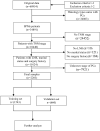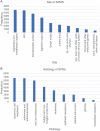Clinical characteristics and overall survival nomogram of second primary malignancies after prostate cancer, a SEER population-based study
- PMID: 33446816
- PMCID: PMC7809269
- DOI: 10.1038/s41598-020-80534-4
Clinical characteristics and overall survival nomogram of second primary malignancies after prostate cancer, a SEER population-based study
Abstract
Prostate cancer (PCa) is the most prevalent cancer among males and the survival period of PCa has been significantly extended. However, the probability of suffering from second primary malignancies (SPMs) has also increased. Therefore, we downloaded SPM samples from the SEER database and then retrospectively analyzed the general characteristics of 34,891 PCa patients diagnosed between 2000 and 2016. After excluding cases with unknown clinical information, 2203 patients were used to construct and validate the overall survival (OS) nomogram of SPM patients after PCa. We found that approximately 3.69% of PCa patients were subsequently diagnosed with SPMs. In addition, the three most prevalent sites of SPM were respiratory and intrathoracic organs, skin, and hematopoietic system. The top three histological types of SPMs were squamous cell carcinoma, adenoma and adenocarcinoma, nevi and melanoma. Through univariate and multivariate Cox regression analysis, we found that the site of SPM, age, TNM stage, SPM surgery history, and PCa stage were associated with the OS of SPM. By virtue of these factors, we constructed a nomogram to predict the OS of SPM. The C-index in the training set and validation set were 0.824 (95CI, 0.806-0.842) and 0.862 (95CI, 0.840-0.884), respectively. Furthermore, we plotted the receiver operating characteristic curve (ROC) and the area under curve (AUC) which showed that our model performed well in assessing the 3-year (0.861 and 0.887) and 5-year (0.837 and 0.842) OS of SPMs in the training and validation set. In summary, we investigated the general characteristics of SPMs and constructed a nomogram to predict the prognosis of SPM following PCa.
Conflict of interest statement
The authors declare no competing interests.
Figures






Similar articles
-
A nomogram for overall survival of second primary cancers following upper-tract urothelial carcinoma: a SEER population-based study.Transl Cancer Res. 2024 Aug 31;13(8):4131-4145. doi: 10.21037/tcr-24-515. Epub 2024 Aug 12. Transl Cancer Res. 2024. PMID: 39262482 Free PMC article.
-
Mortality patterns of patients with tonsillar squamous cell carcinoma: a population-based study.Front Endocrinol (Lausanne). 2023 Dec 7;14:1158593. doi: 10.3389/fendo.2023.1158593. eCollection 2023. Front Endocrinol (Lausanne). 2023. PMID: 38130394 Free PMC article.
-
Analyzing risk factors for second malignancies in early gastric carcinoma from the SEER database.Sci Rep. 2024 Aug 1;14(1):17761. doi: 10.1038/s41598-024-68776-y. Sci Rep. 2024. PMID: 39085575 Free PMC article.
-
Malignancies diagnosed before and after anal squamous cell carcinomas: A SEER registry analysis.Cancer Med. 2021 Jun;10(11):3575-3583. doi: 10.1002/cam4.3909. Epub 2021 May 7. Cancer Med. 2021. PMID: 33960690 Free PMC article.
-
Nomogram predicting overall survival of rectal squamous cell carcinomas patients based on the SEER database: A population-based STROBE cohort study.Medicine (Baltimore). 2019 Nov;98(46):e17916. doi: 10.1097/MD.0000000000017916. Medicine (Baltimore). 2019. PMID: 31725640 Free PMC article.
Cited by
-
Second primary malignancy among malignant solid tumor survivors aged 85 years and older.Sci Rep. 2021 Oct 5;11(1):19748. doi: 10.1038/s41598-021-99260-6. Sci Rep. 2021. PMID: 34611235 Free PMC article.
-
Nomogram for predicting the overall survival of patients with early-onset prostate cancer: A population-based retrospective study.Cancer Med. 2022 Sep;11(17):3260-3271. doi: 10.1002/cam4.4694. Epub 2022 Mar 23. Cancer Med. 2022. PMID: 35322943 Free PMC article.
-
Long-term survival and second malignant tumor prediction in pediatric, adolescent, and young adult cancer survivors using Random Survival Forests: a SEER analysis.Sci Rep. 2023 Feb 2;13(1):1911. doi: 10.1038/s41598-023-29167-x. Sci Rep. 2023. PMID: 36732358 Free PMC article.
-
Clinical characteristics and prostate-cancer-specific mortality of competitive risk nomogram in the second primary prostate cancer.Front Oncol. 2023 May 16;13:918324. doi: 10.3389/fonc.2023.918324. eCollection 2023. Front Oncol. 2023. PMID: 37260974 Free PMC article.
-
Risk prediction of second primary malignancies in patients after rectal cancer: analysis based on SEER Program.BMC Gastroenterol. 2023 Oct 12;23(1):354. doi: 10.1186/s12876-023-02974-2. BMC Gastroenterol. 2023. PMID: 37828423 Free PMC article.
References
MeSH terms
LinkOut - more resources
Full Text Sources
Other Literature Sources
Medical

